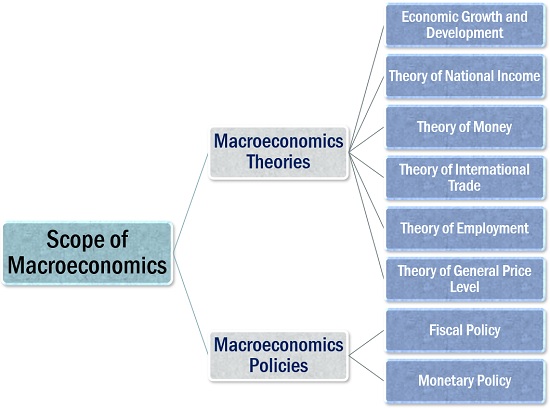
Week # 1 Introduction of Macroeconomics
- The economy in aggregate
- Complexities of the world of business Scope of macroeconomics
- Brief account of the development of macro-economic after the World War-II
Macroeconomics is a branch of economics dealing with the performance, structure, behavior, and decision-making of an economy as a whole. This includes regional, national, and global economies
Macroeconomics: - The word macrois derived from the Greek word makrosmeaning large. It is that branch of economics that focus on the impact of choices on the total or aggregate level of economic activities. Macroeconomics is the study of aggregates of individuals, firms, prices and outputs. In other words, it studies the economy as a whole. It analyses issues such as aggregate level of employment, the general price level, aggregate savings and investment in the economy. The main objectives of macroeconomics are full employment, economic growth, favourable balance of payment and price stability. The major limitation of macroeconomics is that it ignores the welfare of individuals in an economy and it takes into account only aggregate variables which may not clearly explain economic conditions.
Microeconomics differs from macroeconomics in that while microeconomics maps up close how individuals make decisions and how these decisions affect the price and output of various goods and services, macroeconomics analyses not individuals but aggregates of the economy. While microeconomics studies how an individual firm employs its labours, macroeconomics studies the total employment in a given economy. While microeconomics is particularly concerned with the relative prices of goods and service; macroeconomics studies total prices of all goods and services in the economy.
The division between microeconomics and macroeconomics is not rigid, they are interrelated. What affects the part affects the whole while the whole is made up of the parts. For instance, national income is the sum of the incomes of individuals, households, firms and industries. Also aggregates that are studied in macroeconomics are nothing but individual quantities which are studied in microeconomics.Moreover, modern macroeconomics is based upon the study of microeconomics. Therefore, microeconomics and macroeconomics cannot be isolated from each other.
https://en.wikipedia.org/wiki/Post%E2%80%93World_War_II_economic_expansion


